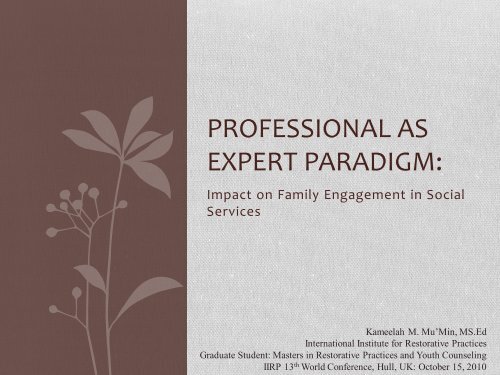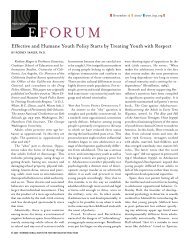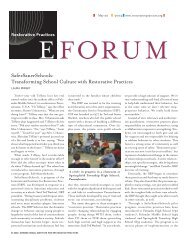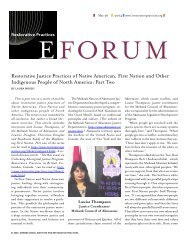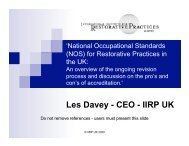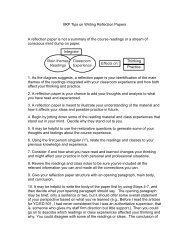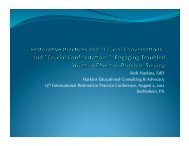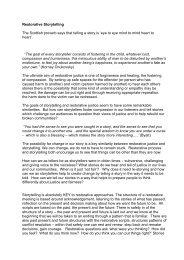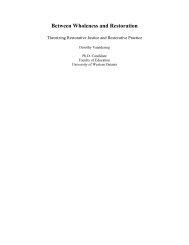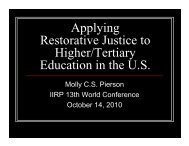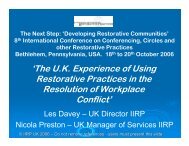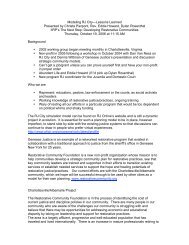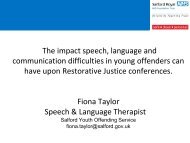Professional as Expert Paradigm: - IIRP
Professional as Expert Paradigm: - IIRP
Professional as Expert Paradigm: - IIRP
You also want an ePaper? Increase the reach of your titles
YUMPU automatically turns print PDFs into web optimized ePapers that Google loves.
PROFESSIONAL AS<br />
EXPERT PARADIGM:<br />
Impact on Family Engagement in Social<br />
Services<br />
Kameelah M. Mu’Min, MS.Ed<br />
International Institute for Restorative Practices<br />
Graduate Student: M<strong>as</strong>ters in Restorative Practices and Youth Counseling<br />
<strong>IIRP</strong> 13 th World Conference, Hull, UK: October 15, 2010
PURPOSE:<br />
to understand the impact a helping<br />
professional’s level of self-awareness,<br />
relational stance, and degree of<br />
cultural competency h<strong>as</strong> on a family’s<br />
subjective experience of therapy or<br />
social service delivery.
The <strong>Professional</strong> <strong>as</strong><br />
<strong>Expert</strong> paradigm is<br />
characterized by the tendency of<br />
the helping professional to view<br />
herself or himself <strong>as</strong> the definitive<br />
authority on a family's narrative,<br />
devaluing the power and<br />
legitimacy of a family’s<br />
understanding of their lived<br />
experience.
Joseph Luft and Harry Ingham 1955<br />
Two American Psychologists develop a model of communication while studying<br />
group dynamics at the University of California ~Los Angeles (UCLA)<br />
Luft and Ingram called their model the Johari Window ; it is widely used in<br />
Business Management, Organizational Dynamics and Leadership Development<br />
The Johari Window is often referred to <strong>as</strong> a 'disclosure/feedback model of self<br />
awareness’ <strong>as</strong> it represents information - feelings, experience, views, attitudes,<br />
skills, intentions, motivation, etc - within or about a person - in relation to their<br />
group, from four perspectives or quadrants:<br />
http://www.businessballs.com/johariwindowmodel.htm
Solicit<br />
Feedback<br />
Accept<br />
Feedback<br />
PUBLIC<br />
PROFESSIONAL SELF<br />
BLIND<br />
UNAWARE SELF<br />
DISCOVER<br />
REFLECT<br />
INTEGRATE<br />
Self-<br />
Disclosure<br />
Mutual<br />
Discovery<br />
HIDDEN<br />
PRIVATE SELF<br />
UNKNOWN<br />
UNDISCOVERED SELF<br />
Self-<br />
Exploration<br />
<strong>Professional</strong> Self-Awareness & Family Engagement<br />
Adapted by K. Mu’Min from Luft & Ingham: Johari Window
<strong>Professional</strong> Self<br />
PUBLIC
Pub-lic<br />
adj.<br />
• Open to the knowledge or judgment of all
Reflection:<br />
Goal<br />
Expand PUBLIC quadrant<br />
to incre<strong>as</strong>e honesty,<br />
transparency, and<br />
accountability<br />
Objectives<br />
Acknowledge what you<br />
do not know or<br />
understand<br />
Recognize the limitations<br />
of your<br />
framework/ideology<br />
Limit the use of<br />
technical/diagnostic<br />
language when speaking<br />
with a family<br />
• Lack of faith in a family’s competence,<br />
resilience and ability is grounded in long<br />
held beliefs about the value of professional<br />
expertise.<br />
• The ‘<strong>Expert</strong>’ tends to reside in this quadrant<br />
if dominant professional discourse<br />
regarding a family goes unchallenged.<br />
• The ‘<strong>Expert</strong>’ seeks to exercise power and<br />
control over a family by virtue of specialized<br />
knowledge and training.<br />
• The ‘<strong>Expert</strong>’ views the family from a deficitb<strong>as</strong>ed<br />
point of view, highlighting pathology.<br />
• From this viewpoint, the professional<br />
believes that his/her role is to “fix” the<br />
problematic behaviors or concerns in a<br />
family. This stance is not only<br />
disempowering and disrespectful, but<br />
potentially robs the family of an opportunity<br />
to use the therapeutic experience <strong>as</strong> a<br />
catalyst for change..
Unaware Self<br />
BLIND
Blind<br />
adj<br />
• Unable or unwilling to perceive or understand; Difficult to<br />
comprehend or see
Reflection:<br />
Goal<br />
Minimize BLIND quadrant<br />
to understand impact of<br />
self on client and family<br />
Expand potential for<br />
GROWTH by being<br />
receptive and humble<br />
Objectives<br />
Actively solicit feedback<br />
from Family<br />
“How w<strong>as</strong> this for you?“<br />
Pay close attention to<br />
your contribution to<br />
ruptures and imp<strong>as</strong>ses in<br />
the Therapeutic Alliance<br />
• <strong>Professional</strong> ‘Therapeucentrism’ is very<br />
active in this quadrant and the family<br />
experiences this <strong>as</strong> paternalistic and<br />
demeaning.<br />
Therapeucentrism: tendency to privilege<br />
our categories of understanding clients’<br />
lives above others. We can mistake our<br />
categories for objectives facts rather than<br />
interpretative frameworks that we develop<br />
to support our work. We become oblivious<br />
to clients’ perspectives, either <strong>as</strong>suming<br />
they are the same <strong>as</strong> ours or simply placing<br />
more stock in our own values and beliefs…<br />
Therapeucentrism inadvertently suppresses<br />
the reality of different perspectives. In the<br />
process, valuable information is lost and we<br />
risk cross-cultural negotiations that are<br />
experienced by others <strong>as</strong> dishonoring them.<br />
(Madsen, p. 27)
Undiscovered Self<br />
UNKNOWN
Un-known<br />
adj<br />
• Not established or verified; unidentified
Reflection:<br />
Goal<br />
Minimize UNKNOWN<br />
quadrant to discover new<br />
<strong>as</strong>pects of self which may<br />
lead to more effective<br />
engagement practices<br />
and collaboration<br />
Objectives<br />
Be open, curious, willing<br />
Utilize supervision and<br />
team consultation to<br />
highlight those are<strong>as</strong><br />
neither you nor the family<br />
perceive <strong>as</strong> barriers to<br />
progress
Private Self ~ Façade<br />
HIDDEN
Hid-den<br />
adj<br />
• Concealed or obscured; secret; designed to elude detection
Reflection:<br />
Goal<br />
Minimize HIDDEN<br />
quadrant to incre<strong>as</strong>e<br />
confidence, authenticity<br />
Embark on acts of selfdiscovery<br />
Understand that who you<br />
ARE, impacts what you<br />
DO<br />
Objectives<br />
Actively seek supervision<br />
Values clarification<br />
exercises<br />
Emotional Intelligence<br />
Quotient<br />
“The stories we create influence the stories<br />
of other people, those stories give rise to<br />
still others, and soon we find meaning and<br />
connection within a web of story making<br />
and story living”<br />
~~The Stories We Live By: Personal Myths<br />
and the Making of the Self<br />
by Dan P. McAdams<br />
I am aware that this quadrant fuels my<br />
strongest personal convictions and<br />
professional commitment to poor families<br />
and families in treatment. My p<strong>as</strong>t history<br />
fertilizes my present and future, and<br />
accounts for my commitment to honoring<br />
family wisdom and strength
SUMMARY:<br />
Self-awareness and reflection on strength and<br />
resiliency are critically important <strong>as</strong>pects of<br />
development for a professional working with<br />
families, particularly those families with multiagency/professional<br />
involvement. Selfawareness<br />
improves one's capacity to<br />
challenge the predominant ideological<br />
framework about a family, focus on resiliency<br />
and address bi<strong>as</strong>es that diminish the ability to<br />
relate in a meaningful, restorative manner.<br />
Reflection should push an individual to<br />
challenge the “professional <strong>as</strong> expert”<br />
paradigm, and to recognize the personal<br />
bi<strong>as</strong>es and weaknesses which reduce the<br />
ability to engage a family in a sincere way.
From:<br />
Collaborative Therapy<br />
with Multi-Stressed<br />
Families<br />
By William Madsen<br />
p. 331<br />
“Although professional<br />
identity h<strong>as</strong> traditionally<br />
been rooted in client deficits,<br />
professional expertise and<br />
professional responsibility<br />
for clients…It is interesting<br />
to ponder what a definition<br />
of professionalism might<br />
look like grounded in<br />
possibilities, collaboration<br />
and professional<br />
responsibility to clients…”<br />
“Imagine the effect if a definition of<br />
professionalism included<br />
accusations like:<br />
It is unprofessional to inquire about difficulties<br />
without having first built a foundation of<br />
competence, connection and hope<br />
It is unprofessional not to actively elicit client or<br />
family members’ wisdom that could contribute to<br />
resolving difficulties in their lives<br />
It is unprofessional to use objectifying language in<br />
any clinical discussion without considering how<br />
clients might experience it or how it might shape<br />
our thinking about clients<br />
It is unprofessional not to actively think about the<br />
ways in which our own <strong>as</strong>sumptions about race,<br />
gender, cl<strong>as</strong>s and sexual orientation affect our<br />
interactions with clients<br />
It is unprofessional not to routinely solicit clients’<br />
feedback about their preferences for the direction<br />
of therapy and the effects of our actions on them.”
CONCLUSION:<br />
As a professional, in order to work<br />
collaboratively and restoratively with<br />
a family, you must discover, reflect<br />
and integrate all <strong>as</strong>pects of the self.<br />
Therefore, the goal is to expand the<br />
PUBLIC quadrant. From the<br />
perspective of your professional self,<br />
your t<strong>as</strong>k <strong>as</strong> a helper, is to be aware<br />
(minimize the blindness), discover<br />
unknown <strong>as</strong>pects of self through<br />
relationship with a family, which can<br />
also lead to personal growth, and<br />
understand the impact your personal<br />
narrative (private self) h<strong>as</strong> on the<br />
stories you privilege and attend to in<br />
relationship.
CONCLUSION:<br />
My narrative h<strong>as</strong> included themes of critical<br />
self-reflection and using the challenges I have<br />
faced in the p<strong>as</strong>t to shape a more positive<br />
future; and to help other individuals and<br />
families do the same.<br />
Unspoken personal histories which drive our<br />
present and future actions are essentially<br />
'veils' we subconsciously create and<br />
perpetuate; consciously removing the veil<br />
(thereby widening the open quadrant) can be<br />
liberating. It is my hope that deliberately<br />
tapping into the power of my story and<br />
sharing it with others can be both a<br />
redemptive and restorative act.<br />
“If you know want to know me, then you must<br />
know my story, for my story defines who I am.<br />
And if I want to know myself, to gain insight<br />
into the meaning of my own life, then I too<br />
must come to know my story… the personal<br />
myth that I have tacitly, even unconsciously,<br />
composed over the years. It is a story that I<br />
continue to revise, and tell to myself (and<br />
sometimes to others) <strong>as</strong> I go on living”<br />
(McAdams, 1993, p. 11).
Further<br />
Reading<br />
• Additional Resources,<br />
Suggestions, etc.<br />
• Of Human Interaction (1969)<br />
by Joseph Luft<br />
• The Self-Awareness Workbook for Social Workers (1999)<br />
by Juliet C. Rothman<br />
• Self-Supervision: A Primer for Counselors and Helping <strong>Professional</strong>s<br />
(2001)<br />
by Patrick J. Morrisette<br />
• Bread & Spirit: Therapy with the New Poor ~ Diversity of Race, Culture<br />
and Values (1994)<br />
by Harry Aponte<br />
• Collaborative Therapy with Multi-Stressed Families (2007)<br />
by William Madsen<br />
• Strengthening Family Resilience (2006)<br />
by Froma Walsh<br />
• Therapeutic Intervention with Poor, Unorganized Families: From Distress<br />
to Hope (2000)<br />
by Shlomo A. Sharlin & Michal Shamai<br />
• Working with Families of the Poor (2007)<br />
by Patricia Minuchin, Jorge Colapinto, and Salvador Minuchin<br />
• The Power to Care: Clinical Practice Effectiveness with Overwhelmed<br />
Clients (1995)<br />
by June Gary Hopps, Elaine Pinderhughes, Richard Shankar
CONTACT<br />
INFO:<br />
Kameelah Mu’Min, MS.Ed<br />
kam_mumin@yahoo.com<br />
+1 (267) 455-4357


